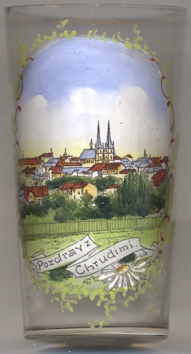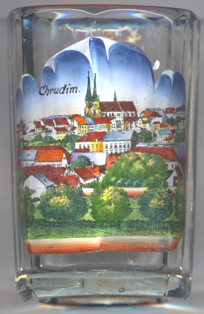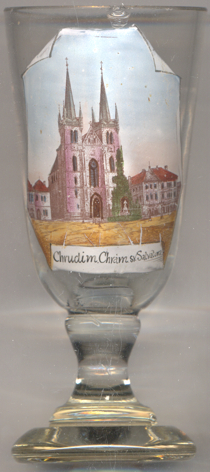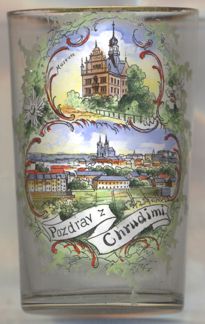

|
| ČESKÁ REPUBLIKA | CZECH REPUBLIC |
| Pardubický kraj | Pardubice region |
| Okres: Chrudim |

 Chrudim is situated at an elevation of 240 m on the river Chrudimka in the Pardubice
region of eastern Bohemia. The municipality has a population of about 23,100 (2018).
Chrudim is situated at an elevation of 240 m on the river Chrudimka in the Pardubice
region of eastern Bohemia. The municipality has a population of about 23,100 (2018).
The oldest archaeological findings which provide first signs of the settlement in this area date back to the 5th millennium BC. Various cultures succeeded one on another in the territory of today’s town of Chrudim and its vicinity. Chrudim town was established before 1276 and soon after came to be a dowry town of Bohemian Queens. Chrudim became the seat of a district in 1751. The medieval ground plan of the historical heart of the town and its suburbs were no longer able to meet the growing requirements. The population reached 13,000 inhabitants at the end of the 19th century. The first industrial factory, with its foundry and forge, and a shoe factory launched industrial development. Social life also greatly expanded in the second half of the 19th century. The number of schools, cultural and social events led Chrudim to be known as “Athens of Eastern Bohemia”.

The  archdeanery church of the Assumption of Our Lady [left, no. 3532, and right, no. 3497: background]
stands on a place that already was the site of an earlier church which seems to have been built in the 14th century. The
construction of the present church began in the Gothic period by the construction of the presbytery and the main nave,
followed by the side naves and the towers on the western façade. In 1702, a large fire hit the church. The towers were
repaired in 1705–1705. Another fire hit the church in 1850. In 1857, the church was renovated in Gothic revival style
by the architect František Schmoranz. The works were finished in 1880. On glass no. 3532 [left]
the church is labeled church of the Holy Saviour. This refers to the fact that a Renaissance copy of the
painting of Christ the Saviour in the Lateran Basilica in Rome, painted by an unknown Czech painter
at the end of the 16th century, was presented to the church and placed in the main altar of the deanery church in 1674. In
1680, a procession against the plague carried the image through the city. Since then, a pilgrimage procession took place
every year until 1782, when it was forbidden by Emperor Joseph II. After 1815, the tradition was restored and, to a
lesser extent, lasted until the end of the 19th century.
archdeanery church of the Assumption of Our Lady [left, no. 3532, and right, no. 3497: background]
stands on a place that already was the site of an earlier church which seems to have been built in the 14th century. The
construction of the present church began in the Gothic period by the construction of the presbytery and the main nave,
followed by the side naves and the towers on the western façade. In 1702, a large fire hit the church. The towers were
repaired in 1705–1705. Another fire hit the church in 1850. In 1857, the church was renovated in Gothic revival style
by the architect František Schmoranz. The works were finished in 1880. On glass no. 3532 [left]
the church is labeled church of the Holy Saviour. This refers to the fact that a Renaissance copy of the
painting of Christ the Saviour in the Lateran Basilica in Rome, painted by an unknown Czech painter
at the end of the 16th century, was presented to the church and placed in the main altar of the deanery church in 1674. In
1680, a procession against the plague carried the image through the city. Since then, a pilgrimage procession took place
every year until 1782, when it was forbidden by Emperor Joseph II. After 1815, the tradition was restored and, to a
lesser extent, lasted until the end of the 19th century.
The  Plague Column [left, foreground] in front of the church was created in
1717–1734 by the sculptor Ignaz Rohrbach.
Plague Column [left, foreground] in front of the church was created in
1717–1734 by the sculptor Ignaz Rohrbach.

The  Chrudim Regional Museum [left, no. 4489: top picture]
is housed in a Neo-Renaissance building constructed in 1898 in the city center. Founded in 1892 as an industrial museum for
Eastern Bohemia, the museum has a vast collection of artisan works and local collections from the Chrudim region. The permanent
exhibit includes an industrial art collection. There are also short-term exhibits focussing on local history, natural science
and art.
Chrudim Regional Museum [left, no. 4489: top picture]
is housed in a Neo-Renaissance building constructed in 1898 in the city center. Founded in 1892 as an industrial museum for
Eastern Bohemia, the museum has a vast collection of artisan works and local collections from the Chrudim region. The permanent
exhibit includes an industrial art collection. There are also short-term exhibits focussing on local history, natural science
and art.
Josef Ressel (1793–1857), the inventor of the first working ship's propeller, was born in Chrudim.
[https://de.wikipedia.org/wiki/Chrudim, https://en.wikipedia.org/wiki/Chrudim;
https://cs.wikipedia.org/wiki/Kostel_Nanebevzetí_Panny_Marie_(Chrudim),
https://cs.wikipedia.org/wiki/Chrudimský_Salvátor;
https://www.muzeumcr.cz/cz/uvodni-strana]
![[scale]](lineal.jpg)